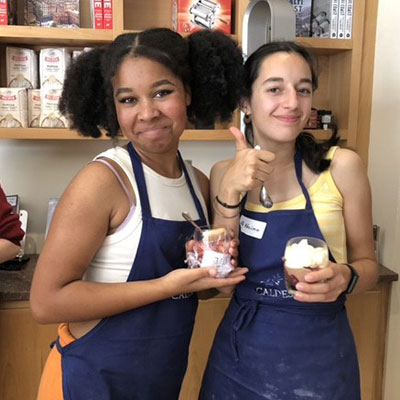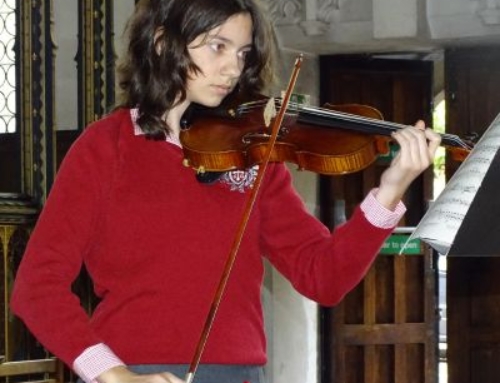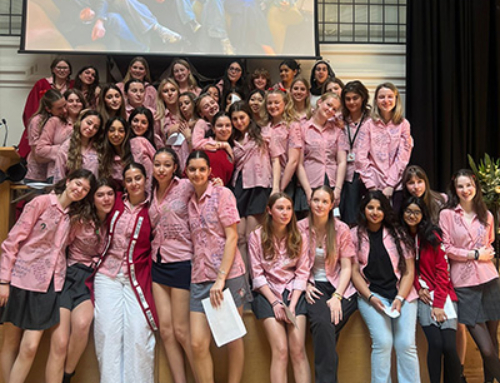It’s Discovery Week!
This week the Lower Fifth have taken a residential trip to Hadrian’s Wall and then language-based trips and activities back in London. Click the below toggles to read more from our student journalists…
Our LV Discovery Week trip kicked off in the medieval city of York. After a quick tour of the city and some lunch, we headed off to Jorvik Viking Centre.
Upon arrival, we were directed to an exciting looking ride. Based on evidence from the York Archeological Trust, the ride took us on an entertaining 15 minute journey inside the lives of the Vikings. We viewed occupations, including that of a blacksmith and trader, saw the interiors of homes and witnessed other aspects of daily life, such as hunting. It was a memorable tour because of the way they recreated a Viking settlement very well with the use of props and realistic looking people engaged in different tasks. The various sounds of people chatting and cats meowing was very cool too!
Once we left the ride, we looked at a number of artefacts on display, including coins, shoes, knives and jewellery, all of which were very well preserved! One speaker told us about jewellery, pigs knuckles (used for past-time games) and an interesting fact. This was that Vikings bathed more than the Saxons did. Saxons bathed once or twice A YEAR and Viking’s bathed every day or every week; so you would have been able to tell the difference between a Viking and a Saxon just from the smell of them!
Another speaker demonstrated how coins were made. This was by using a plain circle of metal, and stamping it using a hammer. The Viking’s only had one type of coin – the silver penningar (or penny). We learned that over time, coins have evolved to have heads and tails. The head represents a monarch (such as Queen Elizabeth which we have today) or someone else of importance (e.g St Peter – a patron saint of York). The other side would be Tails (the teller!) which actually tells you where the coin is from (e.g the Bank of England).
Overall, the Jorvik Viking Centre was great fun and interactive, making it an enjoyable and educational experience. I particularly liked the ride because of how realistic the Viking settlement was and I was able to understand the lives of the Vikings well from it. After asking others, they also agreed that the experience was realistic. I would recommend you visit.
Charlotte de Lisle
Vindolanda was a Roman auxiliary fort, located on Hadrian’s wall, with Roman soldiers and civilians (from across the empire) settling there for a period 290 years. It is one of the best preserved forts, along the wall and thus has been credited a World Heritage Site. While there, a hilarious, yet rather aggressive tour guide presented us with snipits of Roman life at the fort, from the jobs of soldiers in the barracks, all the way to the logistics of a Roman communal toilet. Apparently this being the origins of the phrase ‘grabbing the wrong end of the stick’, as we discovered that a communal toilet, meant communal “toilet roll” as well! Although gruesome, I think it gave us all a different impression of the often romanticised typical Roman lifestyle. Within the fort, we were able to see active excavation taking place and ask the archeologists questions surrounding their work. It was through them that we learnt of the famous Vindolanda tablets; legible letters sent from around the world to the soldiers living at the barracks. In the museum, we were able to view some examples of these and even when the main climax of one was ‘a new pair of socks’, it still gave us insight into individual Roman experience on the fort. Overall, our visit to Vindolanda was a fascinating one, but this influx of knowledge did lead to us all eagerly awaiting lunch!
On the second night right after dinner we went on a short coach ride to the bowling alley.
This personally was my favourite part of the trip as we got to enjoy bowling in groups of six, as well as a dance machine, and lots of arcade games.
The bright flashing neon atmosphere made for a fun and exciting experience, and a perfect way to relax after two intense days of sight-seeing. The bowling alley hosted refreshments and snacks, the most popular being bright blue and red slushies. After enjoying the slushies and bowling, we ended the night with games at the arcade and many won jumbo-sized bars of chocolate and teddy bears in the process.
Overall it was an amazing addition to the trip, and all of us will look back its memories fondly.
Dyala Alusi
Visiting the Roman Army Musuem, the first thing we did was enter a classroom with an impressive hologram of a roman teacher! It was so much more engaging than having a modern day person to explain it, and was a very immersive experience. The roman man taught us about the expansion of the Roman empire, and it felt very historically accurate considering he did not just teach us straight facts, but included his opinion, telling us how proud he was of his empire. The lesson was based on learning the basics of latin, and behind the hologram was a board. It told us a story through a drawn video and then wrote latin words out. Moreover, it showed us how to pronounce the words and the man spoke to us as if he could hear our answers, making it feel that much more realistic! He also taught us the Roman numerals, which was very exciting.
After we had finished our lesson, we watched a 3D movie, which was narrated through the perspective of an eagle. It told the story of a roman soldier and his life on the frontier, making it accurate with the terrible experiences they had to go through, despite the glory and pride that was associated with the army and war.
Lastly, we had a look around at the Roman arms. A few of the artifacts that they had on display was the only surviving helmet crest made of delicate hair moss, the Quintus Sollonius phalera, and the archers thumb guard. In the training room you can see not only replica armour and weapons but also a scorpio minor and a manuballista, both types of Roman artillery.
Similar to London’s Natural History Museum, The Great North Museum (located opposite Newcastle University) is home to exhibits on world history, dating all the way back to the Mesozoic era. The upstairs exhibits focused on world history and we viewed objects from across time, starting with New Zealand’s aboriginal war masks and weapons, before visiting an authentic Egyptian mummified corpse! The museum recognised, that although it was a great honour for these artefacts to now be in their possession, many were stolen from their original people by colonising countries. I felt this was an important message and one that is often forgotten by visitors, so I was pleased of it being recognised here.
Downstairs, the exhibits occupied the history of the North itself. This was particularly interesting, as it is a topic which fails to be prominent in the museums of London. The central exhibition was a model of the entirety of Hadrian’s wall, which included small fact files of one Roman citizen (from across the empire) living at every fort along it. This gave us a new perspective of the individual experience of those living on the wall and this is especially important when studying a period of history such a long time ago, as we often lose sight of the people themselves living through it. The museum was of great interest and I will definitely be planning another visit for the not so distant future!
As part of discovery week, some of the lower fifth visited the National Gallery for the French trip on Thursday afternoon after a three-day visit to Hadrian’s wall. After taking the tube we visited the impressionist galleries, having been informed about impressionism by Miss MacDonnell beforehand.
Impressionism focused on realistic portrayals of natural scenes especially and tended to be painted on smaller, more portable canvases which enabled them to paint outdoors.
The visit wasn’t nearly as eventful as the Thirds’ visit the day before, where they witnessed a climate change protest, but was interesting nevertheless. After going off in groups of three and focusing on three specific paintings, we got some time to explore.
Many paintings were incredibly interesting, but I found Monet’s Water Lilly Pond particularly interesting due to the context. It was painted in 1914, at the start of the first world war, and represents peace in an increasingly unstable world.
It was a very enjoyable trip, even though we didn’t witness a climate change protest.
Uma Iyer
On Thursday, the entirety of the LV, visited the Prince Charlescinema to watch German film ‘Goodbye Lenin!’
Ok, so a comedy about the USSR’s rule over East Germany may seem to some as politically incorrect, while to others the great juxtaposition between genre and topic, would lead them to assume its inevitable failure as a film. However, this is all before they get popcorn in hand and watch the full two hours of Wolfgang Becker’s, Goodbye Lenin!. The film is hilarious.
As a brief plot synopsis: a mother of two and devout lover of the communist regime falls into a coma, after discovering her son at an anti- Soviet rally. While she sleeps the Berlin Wall falls. On awakening, to prevent further shock and another potential heart attack, our protagonist, Alex, must hide this world prominent news from his mother (Christiane), and the story follows his experience of this. But a new currency, and giant Coca Cola adverts appearing outside Christiane’s window, quickly make his job increasing difficult. The most comical moments? Potentially, Alex rifling through some local bins to find an empty jar of East German pickles or perhap Alex’s fake East German television broadcast, in the centre of a local library.
Despite its genre, the film does give a new perspective of the Western “takeover” of East Berlin. Although seemingly an all-positive occurrence, especially to our Western eyes, we begin to understand that the negatives were also rife; increased unemployment, crime and poverty – to name a few. In this way, the film was also an eye-opening one and I left the cinema with a greater understanding on the effects of this darastic change on the citizens of East Berlin.
Overall, the LV had a memorable experience on the trip and naturally a lot of popcorn to digest!
Kiera Nash
Closing off our fun-filled Discovery Week, 22 of us attended an Italian cookery lesson at the wonderful La Cucina Caldesi located in Marylebone.
The session was lead by chef Stefano, who informed us that we would be decorating a pizza each as well as creating a Zuppa Inglese (meaning English Soup). Zuppa Inglese is an Italian dessert; layering custard, strawberries and raspberries, and raspberry sauce dipped lady’s fingers biscuits. It is thought to be derived from trifle.
The chef began by prepping the custard and raspberry dipping sauce, asking different pupils to help stir things along the way. One custard was a smooth and creamy chocolate and the other was a delicious vanilla. He also, demonstrated how to create our Zuppa Inglese, which looked really exciting to make. Then, Stefano moved onto how to make a proper pizza base. It was interesting to feel the different textures of the dough between different stages, as it became thicker and stickier the more it had been kneaded.
Once the prep and demonstrations were completed, it was our go! We began with the Zuppa Inglese, adding the layers of biscuits and custard with the fresh fruit at the bottom of the glass. Some people made very impressive designs on top of their dessert, which I admired!
When we had eaten some succulent focaccia which was given to us, we moved onto our pizzas! The dough was already made for us, as it takes around 2 hours for pizza dough to rise. We kneaded and spread out our dough into a pizza shape, and we had a vast array of toppings to add to our pizzas. Stefano had already prepped the tomato sauce earlier on with us, and said that the best tomato sauce is always made from tinned plum tomatoes, not purée, and most certainly not ketchup! I felt very satisfied once I had put all my toppings on my pizza. I used tomato sauce, mozzarella, basil, olives and capers. After we had put the pizzas in the oven, it was a process of waiting patiently to let the pizza oven do its magic!
In no time at all, we were munching down on our pizzas. The taste was so fresh and the quality of the ingredients tasted amazing! I took a few slices home to share the rest of the moreish pizza. I adored the Zuppa Inglese, and the dish was truly a winner for me! The chocolate cream was particularly wonderful, as well as the raspberry dipped Lady’s Fingers.
Overall, having a cooking session at La Cucina Caldesi was a great experience, because it has inspired me to make the incredible dessert at home, as well as attempting to make my own pizza base because I found it unfortunate that we were unable to do so. I would certainly recommend going to a cooking session over the summer because they are great fun and you are able to pick up new, important skills at the same time!
Charlotte de Lisle
Have you ever fancied putting your dancing feet to the test? Well, a group of LV got just that opportunity when they attended the Salsa and Bachata workshop.
We began by learning the fundamental moves of both styles, before going into to pairs to learn some more complex skills, including several types of turn and a very sassy “catwalk” move! It was certainly difficult to get into the rhythm at first but the workshop leaders speedily got our enthusiasms to a high. An hour and a half later, we were looking extremely professional, performing our dance to a mixture of tracks and there was certainly no tripping or stumbling in sight! At the end of the workshop we were treated with a spellbinding performance from the two workshop leaders, who definitely placed our dancing into perspective.
Although we must have been hilarious to watch, the workshop was great fun and we all left inspired (and of course ready to take up salsa dancing as a living!).
















